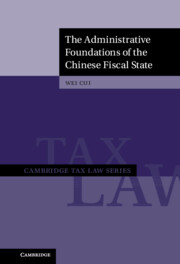Book contents
- The Administrative Foundations of the Chinese Fiscal State
- Cambridge Tax Law
- The Administrative Foundations of the Chinese Fiscal State
- Copyright page
- Dedication
- Contents
- Figures
- Tables
- Acknowledgments
- Abbreviations
- Introduction
- 1 The Forgotten Reform
- 2 What Is an Audit?
- 3 Atomistic Coercion
- 4 Returning Responsibilities to Taxpayers
- 5 Organizing Revenue
- 6 Policy Making without Information
- 7 The Rhetoric of Law
- 8 Varieties of State Capacity
- 9 Pivoting Away from the Rule of Law
- References
- Index
5 - Organizing Revenue
Published online by Cambridge University Press: 24 March 2022
- The Administrative Foundations of the Chinese Fiscal State
- Cambridge Tax Law
- The Administrative Foundations of the Chinese Fiscal State
- Copyright page
- Dedication
- Contents
- Figures
- Tables
- Acknowledgments
- Abbreviations
- Introduction
- 1 The Forgotten Reform
- 2 What Is an Audit?
- 3 Atomistic Coercion
- 4 Returning Responsibilities to Taxpayers
- 5 Organizing Revenue
- 6 Policy Making without Information
- 7 The Rhetoric of Law
- 8 Varieties of State Capacity
- 9 Pivoting Away from the Rule of Law
- References
- Index
Summary
Chapter 5 examines the complex performance incentives used within China’s tax bureaucracy. There is substantial heterogeneity as one moves down the bureaucratic hierarchy. When the national State Administration of Taxation (SAT) evaluates the performance of provincial bureaus, the metrics deployed are few and equalize outcomes. By contrast, provincial performance evaluations of city-level tax bureaus are comprehensive and detailed. Intriguingly, meeting revenue targets receives little weight. The lowest tiers of management in tax agencies—and the “foot soldiers” in revenue management and tax inspection units—face yet another, completely different set of incentives. While promotion opportunities are scarce, they extract financial rewards from the lowest-ranked leaders in the political branch of the state, who are more motivated than tax agency leaders to meet revenue targets. At the same time, they are subject to performance targets in respect of other tax administration outcomes. Maintaining such metrics facilitates top-down management, and keeps enforcement discretion at the grassroots. Overall, it is imperatives from the political organization of the state that ultimately determine the character of tax administration, not the instrumental relationship that the latter bears to policy implementation.
Keywords
- Type
- Chapter
- Information
- The Administrative Foundations of the Chinese Fiscal State , pp. 148 - 177Publisher: Cambridge University PressPrint publication year: 2022

